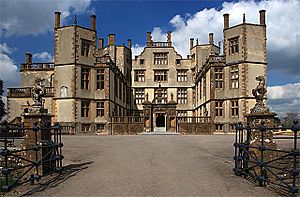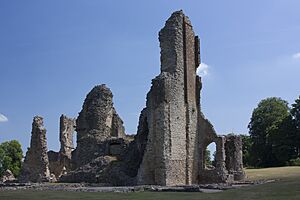Sherborne Castle facts for kids
Sherborne Castle is a grand house in Dorset, England. It's sometimes called Sherborne New Castle. This amazing building was started in the 1500s by the famous explorer Sir Walter Raleigh. He first called it Sherborne Lodge. Later, in the 1620s, it was made much bigger. The castle sits in a huge park that is about 1,200 acres (485 hectares). Close by, you can also see the ruins of a much older castle, called Sherborne Old Castle, which was built in the 1100s.
Contents
The Old Castle's Story
The building known as Sherborne Old Castle was first built in the 1100s. It was a strong palace for Roger de Caen, who was the Bishop of Salisbury and an important advisor to the King of England. In the early 1140s, during a time of civil war called "the Anarchy," the old castle was captured. It was seen as a very important place, like "the master-key of the whole kingdom."
Sir Walter Raleigh's New Home
Sir Walter Raleigh was a well-known explorer and adventurer. He saw the old castle when he was traveling to Plymouth and loved the area. In 1592, Queen Elizabeth I allowed him to lease the land. Instead of fixing up the old castle, Raleigh decided to build a brand new house for his visits.
He finished his new house, Sherborne Lodge, in 1594. It was a four-story building with a rectangular shape. It had four towers at each corner, which looked like they were for defense, perhaps as a nod to the old castle nearby. The entrance was cleverly hidden in one of these towers to keep the front of the house looking perfectly balanced.
The Digby Family and the Civil War
Sir Walter Raleigh later faced trouble and was put in the Tower of London. In 1617, King James I sold the estate to Sir John Digby, 1st Earl of Bristol. In the 1620s, the Digby family added four new sections to Sherborne Lodge. These additions matched the original style, turning it into the large house we now call Sherborne Castle or Sherborne New Castle.
During the English Civil War, Lord Digby supported King Charles I. Sherborne was a strong Royalist area. The old castle was captured by the Parliamentarians (who supported Parliament) in 1642, but the Royalists took it back in 1643. In August 1645, a Parliamentarian army led by Sir Thomas Fairfax surrounded the old castle. After heavy attacks, the Royalist commander surrendered on August 17, 1645. The old castle was then destroyed in October 1645 and left in ruins.
Gardens and Modern Times
From the 1700s to the 1800s, the Digby family, especially William, 5th Lord Digby, created the beautiful gardens you see today. A famous landscape designer named Capability Brown designed the large lake in 1753. This lake helps separate the old castle ruins from the new house. The ruins of the old castle are now a scenic part of the garden.
In 1789, King George III visited the house and gardens. The estate later passed to the Wingfield Digby family, who still own it today. The mansion was updated by architect Philip Charles Hardwick.
During the First World War, Sherborne Castle was used as a hospital by the Red Cross. In the Second World War, it became a headquarters for the commandos who were preparing for the D-Day landings.
Sherborne Castle Today
Both the mansion and the ruins of the old castle are very important historic sites. They are listed as "Grade I," which means they are buildings of exceptional interest. Other buildings on the estate, like the stables, greenhouse, and dairy, are also listed for their historical value. The gardens themselves are also highly recognized for their beauty and history.
Today, the gardens at Sherborne Castle are open to visitors for most of the year. The mansion itself is open to the public on many Saturdays. The estate often hosts fun events like concerts and fireworks. The old castle ruins are managed by English Heritage and can be visited separately.
See also
 In Spanish: Castillo de Sherborne para niños
In Spanish: Castillo de Sherborne para niños




